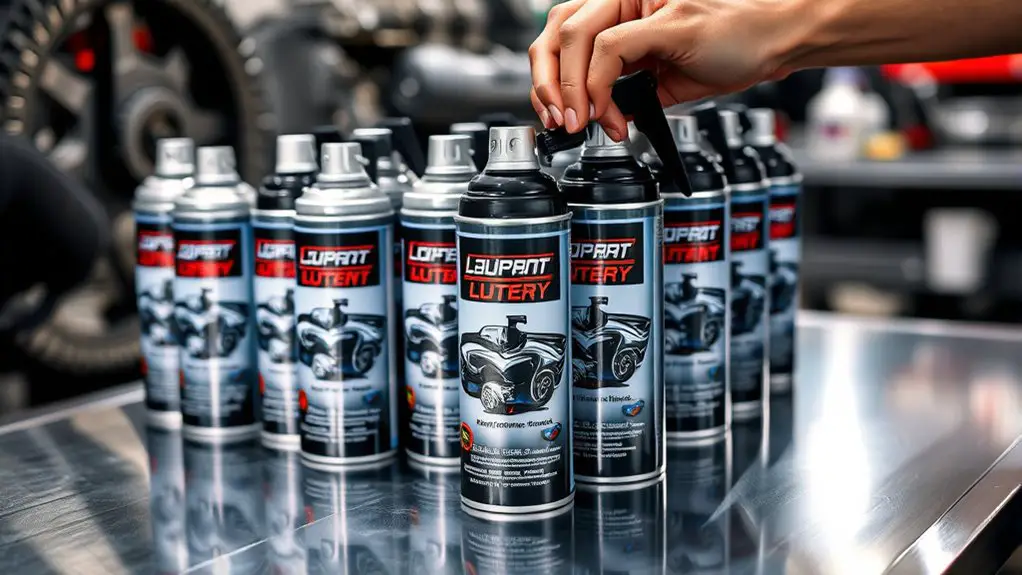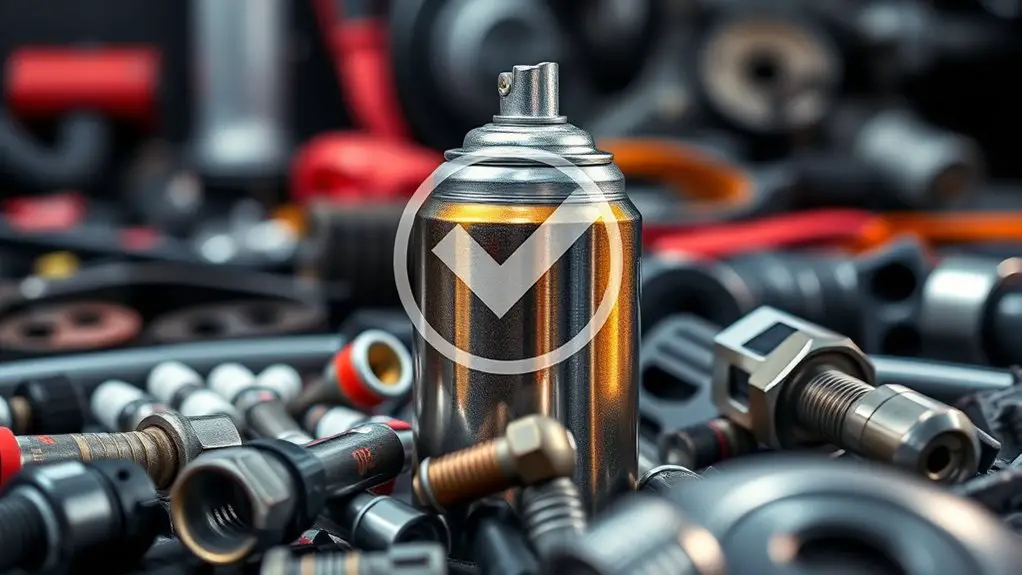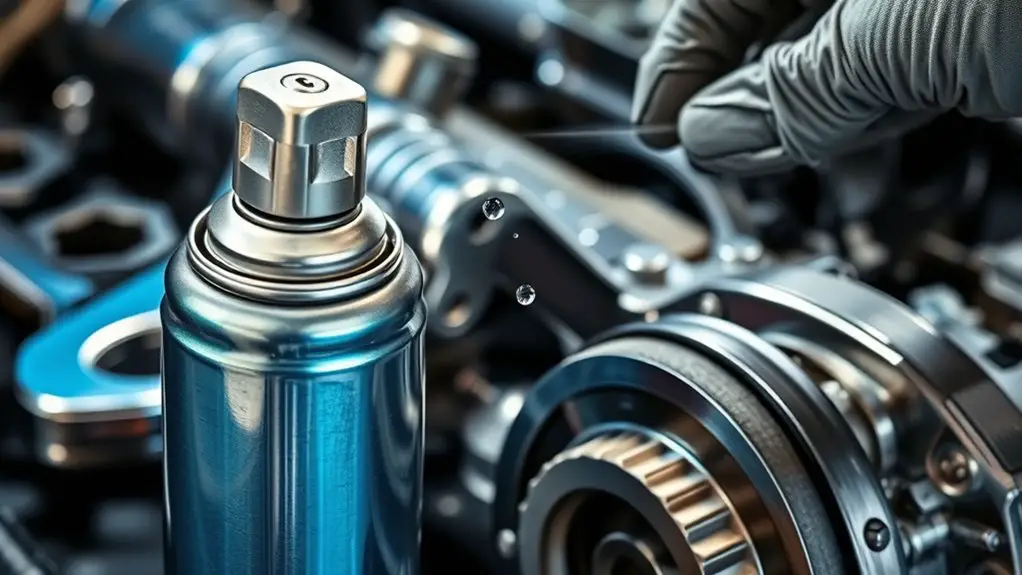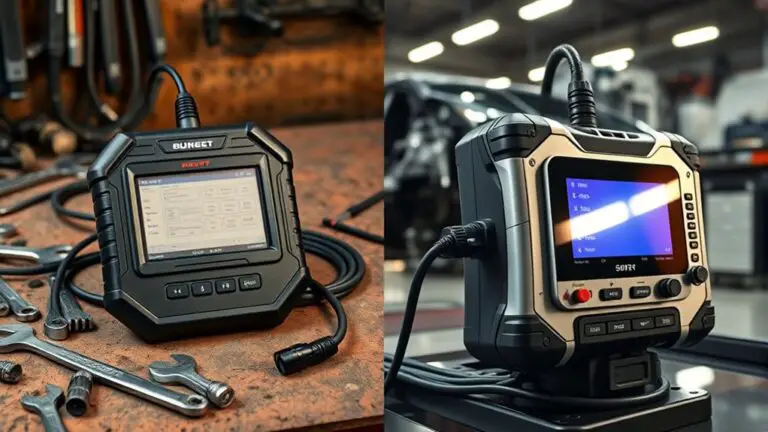How to Test Lubricant Spray Quality After Purchase
Inspect packaging integrity and labels first. Check for damaged seals, leaks, and intact caps or cans, and verify label accuracy with batch and supplier details. Then confirm expiry dates and storage requirements, quarantining any past due or improperly stored items. Evaluate spray pattern and nozzle performance, noting symmetry, reach, and clogging. Assess viscosity at the target temperature, observe residue and drying behavior, and finally test film thickness and longevity to guarantee reliable lubrication; more detail awaits.
Inspect Packaging Integrity and Labels

Inspecting packaging and labels is your first line of defense in evaluating lubricant spray quality. You assess packaging materials for signs of damage, leakage, or compromised seals, because any breach can indicate contamination or reduced performance. Look for intact crimp seals, secure caps, and undented cans, since integrity directly affects spray consistency and safety. Examine the nozzle and spray head for corrosion, blockages, or looseness that could alter spray pattern or volume. You verify label accuracy, confirming product name, batch, and supplier match the purchase record, and that usage directions align with your intended application. Read warning statements and ingredient notes to validate compatibility with your materials and environment. Check batch codes against the supplier’s documentation when available, and confirm tamper-evident features are present if promised. Document any discrepancies and preserve the packaging for reference. This diligence safeguards performance, supports traceability, and reinforces responsible choice in lubricant use.
Check Expiry Date and Storage Requirements

You should verify the expiry date on every lubricant spray and note any that are past or near their stated limit. Ascertain you follow proper storage protocols to maintain quality, including controlled temperature, light exposure, and seal integrity. If storage conditions aren’t met, update records and replace or quarantine affected batches to prevent compromised performance.
Expiry Date Vigilance
To guarantee lubricant spray quality, always verify both the expiry date and storage requirements before use; improper storage can degrade performance even if the product is technically within its shelf life. You’ll keep control by checking the expiry date importance, noting any faint or altered date labeling that could mislead you. Don’t assume a sealed container guarantees safety—oxidation, heat, or moisture exposure can compromise integrity before the stated date. Read the label for storage guidance, then compare it with your environment; if rooms exceed recommended temperatures or humidity, reassess usability. Maintain a clear record of batch and expiry for traceability. When in doubt, replace rather than reuse, and document the decision to uphold consistency, safety, and performance across applications.
Proper Storage Protocols
Strict adherence to storage rules matters: always verify expiry dates and storage requirements before using a lubricant spray, and compare them with your environment to guarantee compatibility. You’ll review the label for expiry, batch, and any storage notes, then assess current conditions in your space. Store in a cool, dry area away from direct heat or open flames, and keep containers sealed when not in use. Note any polymer or solvent warnings that mandate limited exposure to air or moisture. Check storage conditions regularly, especially after transport or a shift in ambient conditions. Temperature control is critical: avoid sudden temperature swings that could degrade performance or safety. If any doubt arises about compatibility, postpone use and consult manufacturer guidelines. Maintain consistent storage practices to preserve spray quality.
Evaluate Spray Pattern and Nozzle Performance

Evaluating spray pattern and nozzle performance is essential for ensuring consistent lubricant application and avoiding waste. You’ll assess pattern symmetry, reach, and droplet dispersion by test-spraying onto a target surface at typical use distance. Look for uniform coverage without gaps, streaking, or excessive misting, which indicate uneven spray and potential waste. Inspect the nozzle for signs of wear or damage, and verify that the stem and seals seal fully between actuations. If you observe irregular flow, pause to clean or replace components, bearing in mind that nozzle clogging can masquerade as inconsistent pattern. Document spray characteristics at multiple pressures or trigger strokes to establish a baseline for spray consistency across conditions. Pay attention to spray angle and fan width; a narrowed or off-center jet signals misalignment or obstruction. Finally, verify consistency over repeated cycles, ensuring the system returns to baseline after rest. This diligence supports reliable lubrication without over- or under-application.
Assess Viscosity at Target Temperature
After confirming spray pattern and nozzle integrity, evaluating viscosity at the target temperature guarantees the lubricant will perform as intended under service conditions. You’ll assess whether the spray remains consistent, coating uniformity, and flow behavior align with specifications across expected operating temps. Begin with a controlled sample at the designated temperature, using calibrated equipment to measure viscosity. Document the method, shear rate, and ambient influence, since viscosity measurements depend on these factors. Compare results against the lubricant’s data sheet and relevant standards to identify deviations that could affect film formation, load-bearing capacity, or rapid thinning. Note temperature effects on viscosity range, ensuring the product won’t become too thin in heat or too stiff in cold. If values diverge beyond tolerance, repeat tests, verify probe cleanliness, and consider corrective actions like storage acclimation or selecting an alternative grade. Maintain clear records to support reproducibility, traceability, and informed purchasing decisions.
Observe Residue and Drying Time After Use
Observe residue and drying time after use to determine how the lubricant leaves a film and how quickly it forms a stable, protective layer on the target surface. You’ll assess residue analysis by inspecting any film remnants and noting uniformity, color, and shininess after application. Drying dynamics matter: observe how fast the solvent evaporates and the coating stabilizes without droplets or halos. Record whether a brief mistcoat yields consistent coverage or if pooling occurs at edges. Consider surface variation and air exposure, as these affect drying rate and film rigidity. Document environmental factors such as temperature and humidity that influence residue behavior. Use these observations to compare products and verify real-world applicability. Table below guides your note-taking efficiently.
| Step | Criterion | Observation |
|---|---|---|
| 1 | Residue uniformity | |
| 2 | Drying speed | |
| 3 | Film integrity | |
| 4 | Edge behavior | |
| 5 | Surface compatibility |
Test Film Thickness and Lubrication Longevity
You’ll start by outlining Film Thickness Metrics to quantify the initial coating and guarantee consistent application across tests. Then, you’ll compare Longevity Performance Tests to establish how long the film sustains protection under typical operating conditions. Finally, you’ll assess Consistency Across Batches to verify repeatability and identify any variances in thickness or endurance.
Film Thickness Metrics
Film thickness metrics quantify the actual protective layer a lubricant forms under operating conditions, focusing on test film thickness (TFT) and how it relates to lubrication longevity. You measure TFT to gauge whether the spray yields sufficient separation between surfaces, reducing wear and heat. TFT values influence how you judge film consistency across batches and spray events, informing replacement or reformulation decisions. When TFT is consistently within target ranges, you gain confidence in predictable performance and longevity. You’ll also assess how TFT correlates with friction reduction and load-bearing capacity, ensuring the lubricant maintains a protective film under peak pressures. These metrics affect application ease, enabling straightforward calibration of spray intervals and quantities. Clear TFT data supports freedom in choosing products that meet your reliability and efficiency goals.
Longevity Performance Tests
Longevity performance tests assess how well a lubricant spray sustains its protective film over time, linking test film thickness (TFT) stability to extended wear resistance and heat management. You’ll evaluate how TFT holds under repeated cycles, measuring duration of protection and temperature control during operation. This is a focused performance evaluation, isolating durability factors from initial film formation. By tracking TFT decay, you gain insight into real-world longevity and maintenance intervals. This approach guides you toward formulations and application practices that maximize lasting film integrity. Use these tests to compare products, establish benchmarks, and identify degradation thresholds. Longer-lasting films reduce friction, improve heat dissipation, and extend equipment life, supporting informed purchase decisions and confident experimentation.
- Test setup and cycle parameters
- TFT measurement intervals
- Degradation thresholds
- Comparative scoring and reporting
Consistency Across Batches
Consistency across batches is essential to confirm reliable TFT and longevity results, as small process variations can create meaningful differences in film formation and protection duration. You assess batch variability by comparing identical test conditions across multiple lots, documenting film thickness, adhesion, and wear resistance metrics. Use standardized application methods, calibrated instruments, and repeat measurements to isolate true changes from measurement noise. Implement tight quality control checkpoints: verify nozzle performance, spray angle, and solvent evaporation rates before each run, and lock these parameters once stabilized. Track lot-specific deviations and investigate root causes promptly to prevent carryover. This disciplined approach helps you confirm consistent performance, reduces risk of premature failure, and supports confidence in product specifications while preserving your freedom to optimize processes.
Frequently Asked Questions
Is There a Recommended Storage Humidity Range for This Lubricant Spray?
Yes. Aim for an ideal humidity range around 40–60% for storage. Keep the spray in a cool, dry place and make sure the cap stays sealed to maintain ideal humidity balance. Avoid high humidity areas or rapid temperature shifts, which can affect performance. Follow storage conditions recommended on the label, and if in doubt, use desiccants or a sealed container. You’ll preserve consistency, prevent corrosion, and maintain reliable spray quality.
Can Aerosol Propellant Choice Affect Nozzle Clogging Risk?
A whisper of wind through a seal—yes, propellant types can influence nozzle clogging risk. You’ll find that heavier propellants may leave richer residues, stressing nozzle design and increasing clog potential, whereas lighter options tend to spray cleaner. You assess compatibility by examining propellant choices alongside nozzle design, looking for smooth, consistent atomization. You’ll want thorough testing that considers spray pattern, flow, and residue. Stay precise, curious, and free as you review the spray’s reliability.
How Does Temperature Cycling Impact Spray Cohesion Over Time?
Temperature cycling can degrade spray cohesion over time, reducing performance. You’ll notice changes in spray consistency as temperatures fluctuate, with potential misting loss or wetting irregularities. Temperature effects can cause nozzle seals to stiffen or relax, altering flow. You should test for consistency across cycles, noting deviations in droplet size and spray plume. To maintain reliability, track how temperature effects influence cohesion, document findings, and anticipate recalibration or storage controls to preserve stable spray performance.
Are There Safety Concerns With Mixing With Other Chemicals?
Yes, there are safety concerns with mixing with other chemicals. You should check chemical compatibility before combining products, as incompatible mixes can release fumes, heat, or cause fires. Follow safety precautions: read labels, use protective gear, and work in a ventilated area. Keep containers sealed, avoid mixing with solvents or cleaners not specified by the manufacturer, and dispose of waste properly. If unsure, don’t mix—consult the product’s safety data sheet for guidance.
Should I Perform a Field Test on Multiple Surfaces First?
A field test can reveal early issues, so yes, you should consider trying it on multiple surfaces first. You’ll assess surface compatibility and spray consistency before broader use. Start with small, controlled applications and compare results across materials. Look for spray pattern, drift, and residue. If anything looks off, stop and reassess. This approach helps you confirm reliability while preserving freedom to choose the best-performing option.




